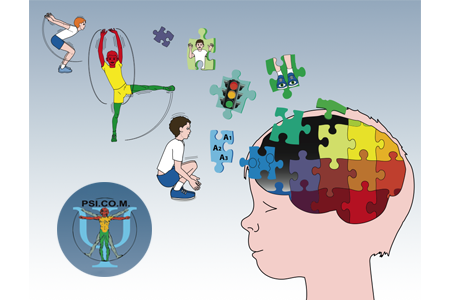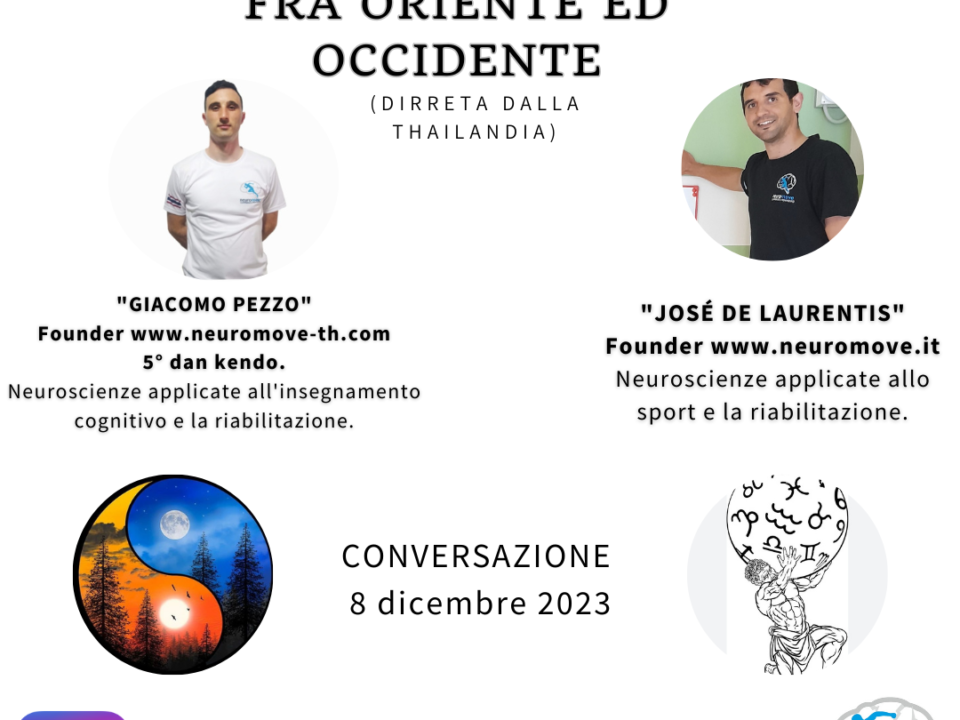- Motion Realizing
- info@neuromove.it
AN APPROACH TO THE “PSI.CO.M. SYSTEM”

Borges said "that what is good or excellent” no longer belongs to a man or group of men (as the book "on the move" the foundation carmelo Pittera) "The good now belongs to no one, it belongs to the culture" as the idea of Mario Di Santo and his group of study “Eucinesis”Or as the eastern creativity Javier Capitaine and his “Global Systemic Activation“. However, these genes of the movement can be called pioneers of human movement, considering their experience and interaction with the scientific culture.
The Carmelo foundation Pittera He has developed an educational system called PSICOM, which published the book, whose scientific theory is a methodology of motor learning and problem solutions through the cognitive apparatus: Namely memory processes, auto-space-temporal associations represented, symbols, attentional elements. This cognitive apparatus is trained through a simple method, but it was not frowned upon educational and sports until a couple of decades ago: “Play!!!”; word that bothers a lot of what you're used to seeing in gyms, schools or sports clubs, or follow orders without knowing it the meaning it is intended. Value of the game, however, is very high, because once placed the camera, leaving the student to the task of solving the mobility problems that arise for its resolution, with a very important basic motivation: fun.
I suspect that all those who believe, and have believed in the "game" as a physical education method are excited about these new paradigms that arise from neurocognitive psychology and neuroscience, unknown until a few years ago but, despite everything, they are based on the essential principles and established scientific, reason why they can not be considered as a “fashion” or a simple ideology, on the contrary as the truth that we must begin to accept.
Does not exist game mathematician, neuropsychomotor, sportsman or even at the table who does not make use of the cognitive apparatus for its resolution, or to meet its objectives.
The foundation Carmelo Pittera understood this concept very well, and thanks to its vast experience has structured a series of eight open methodologies and combined with each other, among which stand out:“The translation of postures and movements in the different planes” and “The vocabulary of movement “; through these educational, Universal defined as the symbols used breaks down any cultural barrier (such as the color of the traffic light, also known around the world), they are developed skills such as scientific observation, reasoning about the movement communication in children for his learning and creativity.
After a neurocognitive hard work of its researchers, it seems that this whole methodology was created following logic older brain, unconsciously, with willpower, for the energy saving of the central nervous system in professor, who, following the motto of the foundation, should intervene as little as possible, the right need, so that responsible learning psycho-cognitive-motor, and at the same time protagonists are the children themselves .The Performer report, Observer and Reporter It is a clear example of a learning without instructors (the system is another methodology).
The “natural History” and the system PSICOM
“The adaptive and evolutionary value of the vision lies in the cognitive component”. Already understood Pliny the Elder, where the “natural History” It argues that the organ of sight is not the eye, but the mind. However what Pliny the old man could not know is that the ability to remember pictures is highest during childhood and tends to decrease with age. (Page 78, “PSICOM system”).
The Natural History (79 dC) It is one of the great texts in Latin, type encyclopedic (innovative for its time), which collects the ancient Greek knowledge, and some discovery in that this distance, that despite being fundamentally scientific in that time, is currently considered more ironic for her popular character, fantastic, mythical, that Pliny expressed through its literature. The absence of Mathematics is the most critical observed for this text.
The texts of Pliny the Elder have been widely studied, and its traces have remained until today. Yes, so far through the book of the foundation Carmelo Pittera, that thanks to it we can learn that eidetic memory, (from the greek eidetikós, Derivative eídesis “knowledge”) It can be considered as a cognitive process. So what I see is what I am, and it is also what I am learning.
The objectives of the system PSICOM
The objectives of this system also have a strong influence on education. In addition to giving motor skills an important role in the development of new synapses, as well as promoting dialogue between the two hemispheres, they teach students above all to think for themselves, to solve problems and to dissociate themselves from everything, today's social dynamics try to offer us without interest. the commitment of our cognitive system. I hope that this educational system can help us discover these abilities of ours, with which we structure our values, meanings and objectives. Even if a question arises spontaneously: can education in the movement achieve these goals on its own? Or is the intervention of other sciences necessary, such as philosophy? Only experience can reveal the answer. Again, sometimes who I am is very different to what I see and learn.
Constructive criticism on PSICOM methodology
A technical critique on the excellent methodologies, is the lack of emotional and sentimental readings games, which I consider innate in humans ie it is possible to genetically, yet unconsciously, feel the emotion of an individual (it was necessary in the evolutionary development of our species and the other for survival).
The tension or relaxation, the heartbeat, fear, distrust, pallor, tired posture, or depressed, surprise, shame; all these emotions we perceive them as mammalsBut thanks to these types of methods you could use to be taught to recognized. Maybe it will be the goal of Neuromove.
The proposal that you could offer, is the development of cognitive games with more physical contact between participants, with more use of channels “Tactical-proprioceptive” for troubleshooting. It is believed that it would be very useful to react to sviluppre engrams engines, through tactile stimuli that both occur in some sports, where the balance and the decision taken has to do with contact with the opponent.
Metaphorically, genetically speaking, you can not forget the warmth of his mother, and the embrace of the Father. We come from these feelings, we are mammals, we have developed physical / emotional contact with our parents nowadays are gradually disappearing because of too much technology in this way harmful.
PS: Thanks to the foundation “Carmelo Pittera” for valuable lessons, which also contributed to Neuromove project.
Sources:
Carmelo Pittera Foundation, The PSICOM system
Pliny the Elder, Naturalis Historia La.
Sensory Systems, National University of Villa Maria Cordoba, Argentina.
Discovery Channel's.Il First Man.
Michel Foucault, "The microphysics of power"
Borges, Funes memorioso yl.
Author: José De Laurentis.





